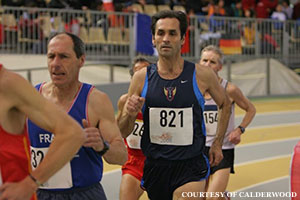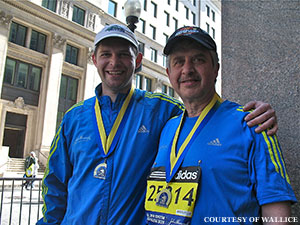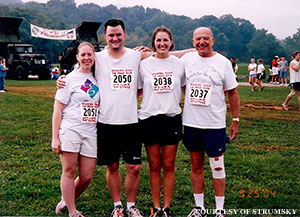It is approaching that crystalline point of a pleasant evening, the 7 p.m. dusk after a sun-kissed afternoon, and without more than a glimmer of sweat or a trace of fatigue, Stuart Calderwood (below) has just finished his daily run for the 8,841st consecutive time.

He did a three-mile figure-eight loop around the reservoir in Central Park -- the route he takes four times a week -- jetting north up Fifth Avenue from his office building at 89th Street before turning left at 90th.
His first steps are always slow, deliberate, "making things warm up" he likes to say, allowing his 52-year-old leg muscles time to loosen.
On this warm day that was easy -- not like when he ran the Philadelphia marathon in a 26-degree freeze, or trudged through the New York City blizzard in December -- and by the time his white Asics hit the soft dirt bridle path inside Central Park he's cruising, revving up to the seven-minute-mile pace he likes, able to predict the numbers on his Timex stopwatch to the near-second.
"I got very lucky to have found running as the sport I like," Calderwood says.
There are those who dedicate themselves to fitness, who carve out an hour most days for a workout, who want to keep in shape. There are those who train for races and those who seek to rekindle the racing form they once had. Stuart Calderwood has run at least one mile every single day for the last 24 years.
It is the longest such streak in New York City and, according to the United States Running Streak Assn., the governing body that monitors such activity, it is the 75th longest current streak in the nation, about five months behind William Terrell of LaGrange, Ga., and 18 years off the pace of the current leader, 60-year-old Mark Covert of Lancaster, Calif., who has been running daily since July 1968.
Calderwood holds a slight lead over John Wallace III -- who once ran less than 12 hours after an appendectomy -- and Mark Washburne, a history professor and marathoner from New Jersey. Yet he seems ages behind John Watts, a 55-year-old pastor in western Idaho who has been running around the potato farms near his home every day since 1980.
People begin running streaks for countless reasons, and it's impossible to prove their veracity. Nor is there any prize or remuneration for holding one. Calderwood and his brethren have simply yet to open their eyes to a morning devoid of a desire, or perhaps need, to go for a run.
"I have a goal of having the longest running streak anyone's ever had," Calderwood says, adding: "I like seeing the years add up."
**
Currently 272 men and women have filled out and signed the U.S. Running Streak Assn. certification form, submitted their running log books, paid the $20 yearly membership fee, run for at least 365 consecutive days and pledged to stay on the list only if they've run at least one continuous mile per day, one of the association's only rules.
They are armed service veterans, dentists, farmers, secretaries, firefighters, bankers. There is a construction worker, a school bus driver, a concert pianist and a circus owner. There is a man in his late 70s and a 19-year-old college student. There are 11 people who began in the same year (1978), and seven people who began on the same day (January 1, 2009). There are two people from Montana, their streaks 27 years apart.
All are tethered by a common compulsion: to never be too injured, sick, sore, tired, depressed, hungover, sleepy, hungry, full, busy or lazy to finagle their way out of exercise, to skip a day of running.
"Some people say I'm obsessed or I'm obsessive-compulsive, and I am probably, as all of us on the list are," says Watts, the pastor who began his streak Oct. 4, 1980. "But it doesn't feel that way to me."
Watts usually leaves his house in the predawn darkness, jogging a six-mile square near his home in Nampa, Idaho, and up a small hill so he can see the town waking up before him.
"I didn't intend to start a running streak," Watts says. "Before long I realized it'd been a week, then two weeks, then a month. Once it got to that point, it was like, 'I don't want to break the streak now.' I've been running ever since."
The reasons people start running streaks are countless. A good run one day leads to another the next, tripping into a continuous week and then a month, and so on. Calderwood began his because he wanted to improve his competitive racing times. Watts wanted to get into shape. Washburne wanted to see how long he could last.
John Wallace Jr. and his son, John III (below), started running together Dec. 31, 1989, when the younger John was 14 years old. After a week, they made a $20 bet over who would miss the first day.

"It's been going on ever since," Wallace III says.
Harry Warren, 59, a museum director from Whiteville, N.C., doesn't really know why he started his streak in late December 2001. It soon became an addiction, he said, even though he wasn't aware of the association that kept track of streaks until a few years ago.
"My first feeling was, 'Thank God I'm not alone,'" says Warren with a laugh.
Over more than 8,800 days of running, Calderwood says he has averaged 9.2 miles. That includes 55 marathons and the relatively shorter runs he does the day before and after them. He describes the time he ran with several broken ribs as the most uncomfortable ("For 10 days I had to run practically holding my breath on a treadmill uphill so there wouldn't be any shock. It hurt like hell."), and the time he ran back-and-forth inside a 10-foot jail cell in London for an hour the most bizarre (after a mixup following a stolen passport). On the afternoon of Sept. 11, 2001, after watching the second tower fall from his office building downtown, Calderwood met his running group in Central Park and went for the most emotional jog of his life. Nobody said a word.
"We could smell that burnt, horrible smell the whole time," he says.
Washburne, 55, the association's current president and a history professor at County College of Morris in New Jersey, has yet to spend a day of his 22-year streak on a treadmill. He avoids the northeastern blizzards as much as possible.
"I'd wait for the snowplow to come and be running right afterwards," Washburne says.
Once, on a vacation in Peru, Washburne kept his streak alive jogging through the Incan ruins at Machu Picchu.
"This woman with a British accent said, 'You know, you don't have to exercise on your vacation,'" Washburne says. "It was kind of a funny moment. Sure, I was in Machu Picchu. But I was getting in my miles."
**
After 40 years of incessant, painstaking, uninterrupted running, streakers receive a bronze plaque inscribed with the words "Presented To A Legend". Their names are published in the association's newsletter. They keep running.
There are any countless reasons how people start running streaks. But the essential question always comes back to why.
As a 17-year-old preparing for his first season of cross-country at Cal State Fullerton in Southern California, Mark Covert went on a run outside his home. That was on July 23, 1968. After the first 100 days, he wondered if he could go a year. When it got to a year, he pushed for two.
There is no real force pushing Covert now, 42 years later, to remain atop the nation's list of durable runners. If you ask him, nothing too extraordinary about his streak stands out.
Stubborn, dedicated, addicted -- he, like the rest of the runners on the list, is all of these things. But Covert insists he is not simply running for a plaque.
"I like putting my shoes on, I like going out for a run," says Covert, who is the track and cross-country coach at Antelope Valley College in Lancaster, Calif. "Even on the toughest days, it's something I look forward to doing. I can't say I've had any days where I’ve thought, 'Geez, I've got to get a run in.'"
Many of the runners speak about the health benefits of running every day: few injuries and illnesses, fit bodies, even psychological improvement.
"I just feel better, I have a better mental outlook," Warren says. "One of the nice things about running first thing in the morning is you know you won't do anything any worse the rest of the day."
But running streakers also have their share of detractors and often find themselves equally discouraged by those who lament the downsides of running everyday. They're cast off as crazy or obsessed or egomaniacs and criticized by some physiologists who preach moderation in exercise. There is almost always some amount of sacrifice involved, which can add strain physically as well as in family life.
Some streakers themselves, including Covert, offer stern warnings to those who might want to begin: It's not easy and it's not for everybody.
"A day off once in a while when you're hurt or sick, you're probably better off doing that," Covert says.
Wallace III, who ran a mile one Christmas Day after having emergency appendectomy surgery a day earlier, says he is constantly told he shouldn't be doing what he does. But he believes every person's body and tolerance level is different.
"For someone who doesn't run, they might look at it and say it's too much," he says. "But for us it's not."
George Hancock, the man who created the first list of running streaks in 1994, doesn't believe it's unnatural for a person to want to run every day. In 1993, Hancock saw a letter to the editor in a popular running magazine asking if any statistics were kept about streaks. The answer, at the time, was no.

This surprised him. He had heard about Ron Hill -- a renowned British marathoner who reportedly had been running every day since 1964 -- and Hancock himself had been keeping a streak going since 1978. "The idea of seeing how long you can keep that up -- I didn't think was that alien," he says. "I thought there were more of us out there."
So he paid the postage to mail 200 letters to every running club in the country asking if any members had a streak going. In December 1994, Hancock's initial list of 51 active running streaks appeared in an issue of Runner's Gazette magazine.
Hancock held sole responsibility for the list until 2000, when a Baltimore running streaker named John Strumsky (above, far right) took over to start an incorporated national group with its own website, advisory board, newsletter and membership form. The first U.S.R.S.A. official list contained 113 runners.
"It's just incredible how a simple little letter in a little magazine has turned into, if you want to call it a movement you could probably call it that," Hancock says.
Covert, like most runners, doesn't want to think about the day he may have to stop. He has been fighting through a minor back injury recently, causing him to retract his daily mileage a bit, from nine miles to four or five. But that hasn't stifled his desire to keep pressing forward. No circumstance has yet to extinguish his passion for a jog.
"I just want to be able to get out tomorrow," he says. "I don't have any goal to make it to July 23 again. I don't have a goal to make it 45 years or 50 years. I've always just looked forward to the next run."
Part of the psychology of the streak is that the question eventually shifts from how to keep going to how to stop. It is part of the ferocity of the addiction, and the burden that runners eventually have to drag along behind them.
Covert insists that running for 42 years has not been a burden. He knows the day will come when a mile becomes impossible to complete.
The official definition of a streak has always stayed the same: run at least one continuous mile within each calendar day under one's own power, without any mechanical aid other than prosthetics.
Stay on the list until you're unable or unwilling. Run for 40 years and you receive a plaque.
Pause for a moment to recognize and reflect on what four decades means in terms of hours, sweat, miles, feet. Keep running.
**
Later in the evening, Calderwood and his eight-year-old son, Kieran, walk up Broadway toward a pizza parlor. Under the streetlights, the boy races to the edge of street corners and leaps over garbage piles, seemingly unable to contain his energy.
"I was a little like that," Calderwood says, urging Kieran to practice a cartwheel on an empty stretch of sidewalk. Part of the reason Calderwood likes to run is how it makes him feel: not necessarily as he is running, but afterward, in the office, at home, playing with his son.
"Some guys my age, I see them running and I think 'God I hope I never get like that,'" Calderwood says. "Even though they're fairly fast, they're just so stiff. I watch myself in treadmill mirrors and I still look the same [as decades ago]. I'm not worried yet."
Calderwood says he hasn't been sick since grade school, doesn't get a flu shot and has never visited a doctor.
"Runs are not just exercise or training to me," he says. "I think of many as symbolic sometimes. A simple state -- an essential, simplified state where anything superfluous is bad. There are no frills that hurt you. You're just dealing with what will move you forward. You don't fabricate it.
"I feel running is a time in which you're doing what you're doing and nothing else. I'm acting rather than examining."
It is a sentiment shared by many other runners -- exercise is one of their few opportunities to break away from daily strain and struggle. It is a time to be alone, and free, and no matter what the circumstances, streak or no streak, their daily priority is simply to set aside a few minutes to get there.
When Calderwood runs, he checks his times. He hears his feet. He notices the trees he has used as checkpoints over the years.
He does not listen to music. He listens only to the harmonious syncopation of short breaths and steps, the beat of blood rushing to the forehead and the tingle of lactic acid through the legs. He listens to his own body's rhythm, the light pulsing melody he has trained and grooved.
He listens, too, deftly, fearfully, for the first sign of the inevitable he cannot outrun -- that dark, distant, dreadful morning he will say, "I just can’t run today."




